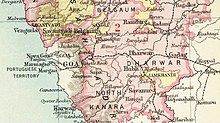| Savanur State ಸವಣೂರ ಸಂಸ್ಥಾನ | |||||||||
|---|---|---|---|---|---|---|---|---|---|
| Princely State of British India | |||||||||
| 1680–1948 | |||||||||
 Savanur State in the Imperial Gazetteer of India | |||||||||
| Area | |||||||||
• 1901 | 189 km2 (73 sq mi) | ||||||||
| Population | |||||||||
• 1901 | 18,446 | ||||||||
| History | |||||||||
• Established | 1680 | ||||||||
| 1948 | |||||||||
| |||||||||
| Today part of | Karnataka, India | ||||||||

Savanur State,[1] Nawab of Savanur was one of the princely states in British India. The last ruler of the state acceded to the Dominion of India on 8 March 1948, becoming part of the Bombay State. Later in 1956, it transferred to Mysore State in what is now Karnataka.
Savanur is also famous for Baobab trees planted there in ancient period. It is locally called Dodda Hunise Mara.[2][3]
- ^ Imperial Gazetteer of India, v. 22, p. 155.
- ^ Aravamudan, Sriram (30 July 2018). "The greenskeeper: The Big Baobabs of Savanur". Bangalore Mirror. Retrieved 27 October 2023.
- ^ "Savanur's ancient baobab, one of the trio, falls down due to termites, weather". The Times of India. 10 July 2023. ISSN 0971-8257. Retrieved 27 October 2023.